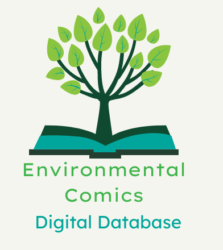The Environmental Comics Database was created by Brianna Anderson, a PhD candidate in English at the University of Florida, as the first chapter of her dissertation, Greening the Gutters: Visualizing Environmental Disaster and Youth Eco-Activism in Children’s Comics. The project argues that argues that the unique multimodal properties of comics, graphic novels, and zines enable these texts to serve as powerful eco-pedagogical tools that can empower youth to grapple intellectually and politically with large-scale environmental catastrophes and environmental injustice.
This digital project investigates how comics—and, by extension, visual popular culture and other forms of imagetexts—can disseminate knowledge about environmental problems and imagine potential solutions in accessible narratives that appeal to more diverse audiences than those reached by technical scientific research alone.
The digital chapter uses several digital tools and platforms to present data related to children’s environmental comics. All of these resources are available free of charge for non-commercial use. The project consists of two main parts:
The Environmental Comics Database
Built using the WordPress platform, the digital database catalogs over ninety children’s and young adult comics and zines that prominently feature environmental issues.
Data Visualization
Many children’s and young adult comics depict empowered young protagonists who express concern for the environment and take action to help combat environmental issues, either individually or through collaborations with others. By raising awareness of environmental issues and actively working to solve them, these protagonists demonstrate young people’s capacity to exert agency, which Allison James and Adrian James define as “children’s ability not only to have some control over the direction their own lives take but also, importantly, to play some part in the changes that take place in society more widely” (4). Like real-world youth activists, youth protagonists with high levels of environmental agency–the ability to recognize environmental issues and injustices, positively impact the environment, and address environmental crises through direct action and activism–challenge popular discourses that often frame young people as passive and powerless.
However, environmental comics can also perpetuate systemic issues of representations of age, gender, sexuality, social class, and race, leading to two important questions: Who gets to save the world in an environmental comic, and who gets left out of these narratives? To address these questions, this website includes data visualizations developed using the tool Flourish that draw from 72 children’s and YA environmental comics from a variety of genres. Click here to view data visualizations about Environmental Themes and Representations of Youth Agency, as well as Gender and Race in Environmental Comics.
